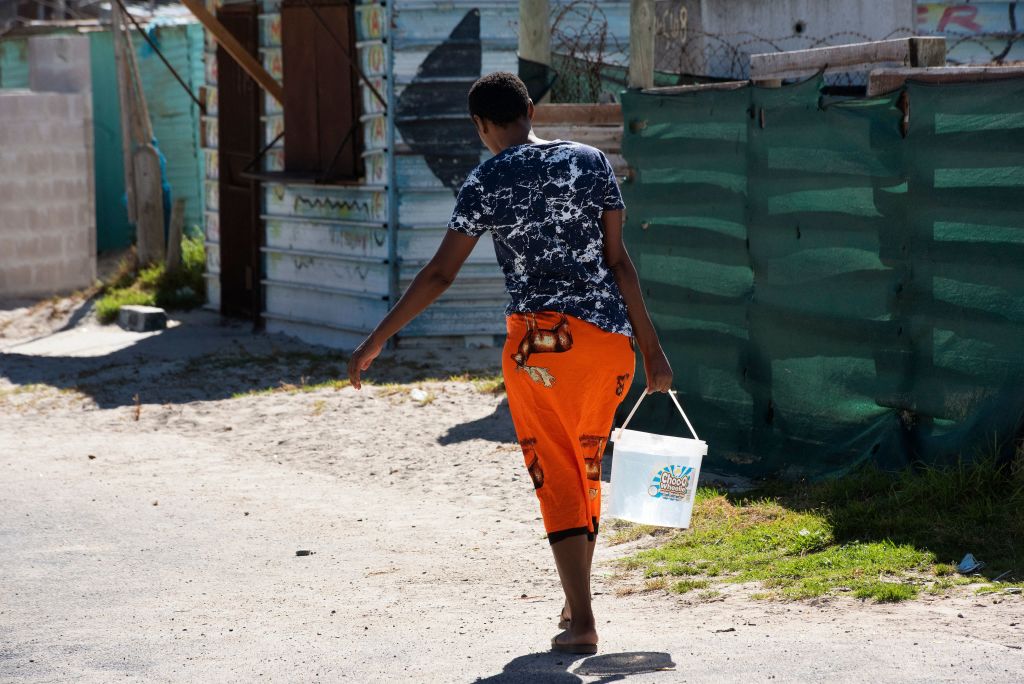
From Phoenix to Tehran to Mumbai, water shortages are becoming an ever greater concern for city officials. And when the wells run dry, we tend to blame two things: climate change for increasing droughts, and population growth, for putting more pressure on local resources.
But a study published Monday in the journal Nature Sustainability argues that we’re overlooking another key driver of urban water shortages: the wealthy. Researchers from several European universities write that, by filling swimming pools and maintaining green lawns, cities’ highest income residents directly contribute to the shortages that leave poorer residents struggling to drink, wash, and cook. Tackling this inequity, they say, is the easiest way to limit future crises.
The study focused on Cape Town, a city famous for its proximity to water catastrophe. In 2017, amid a severe drought, officials announced a “Day Zero” was approaching, when reservoirs would run so dry that residents’ taps would have to be turned off. The entire city successfully mobilized to avert that, launching a belated effort to fix up long-neglected pipes, which were thought to be leaking up to a third of the city’s water. Equally important was an aggressive public information campaign and rules, enforced essentially by public shaming, that limited water use to 13 gallons of water per person per day. (The average American uses 82 gallons a day).
While Day Zero never arrived, Cape Town remains water stressed. And officials worry that looming population growth and worsening climate conditions could bring more shocks in the coming years.

But as the researchers suggest, the most immediate threat to Cape Town’s water may be its wealthier residents. Using a model to estimate the water use of five different socioeconomic groups, researchers found that elite and upper-middle-income families, who make up less than 14% of the city’s households, consume 51% of its water. By contrast, lower income and informal households, who make up 62% of the total, consume only 27%.
The different groups use water for different reasons. Roughly two thirds of water used by Cape Town’s elite—a group that makes up 1.4% of households and uses 10.3% of the water—goes toward “non-basic” purposes like “the irrigation of residential gardens, swimming pools and additional water fixtures, both indoor and outdoor.” Meanwhile households in the two lowest income brackets use virtually all their water for essential activities like washing and drinking.
More from TIME
The study also found that, despite being accustomed to lower water use, poor people suffered more during the “Day Zero” crisis. Between 2015 and 2017, the city began charging more for water to discourage use. Despite a scheme to keep prices affordable for those in need, the lower income group cut its consumption from an average of 43 gallons per household per day to just 22 gallons—a level the researchers say would have affected their ability to cook, clean, wash, and do laundry. Meanwhile the highest income group cut its water use from 559 gallons per household per day, to 353 gallons. That may have meant not watering the lawn, but wouldn’t have hit their basic needs.
The drought also set up a worrying trend for the future. As well as being able to pay the higher tariffs and fines for excessive use of public water, many wealthier households also moved to establish private sources of water, like drilling wells on their properties, or building rainwater harvesting devices. The researchers say that means “well-to-do Capetonians” not only put unsustainable pressure on public reservoirs, but could also “eventually deplete the groundwater sources in the area.”
As climate change makes droughts more frequent and intense, some cities are already experimenting with ways to enforce fairer water use. Last year in Los Angeles, for example, when fines failed to stop wealthy residents from using excessive amounts, local officials began installing “flow restrictors” in the pipes serving offending homes.
More local governments may be forced to consider such measures going forward. Up to 2.4 billion city residents are expected to face water scarcity, per a U.N. report published in March, compared to about one billion today. “Our projections show this crisis could get worse still as the gap between the rich and the poor widens in many parts of the world,” said Hannah Cloke, a hydrologist at the University of Reading who co-authored the study. “Ultimately, everyone will suffer the consequences unless we develop fairer ways to share water in cities.”
More Must-Reads From TIME
- The 100 Most Influential People of 2024
- Coco Gauff Is Playing for Herself Now
- Scenes From Pro-Palestinian Encampments Across U.S. Universities
- 6 Compliments That Land Every Time
- If You're Dating Right Now , You're Brave: Column
- The AI That Could Heal a Divided Internet
- Fallout Is a Brilliant Model for the Future of Video Game Adaptations
- Want Weekly Recs on What to Watch, Read, and More? Sign Up for Worth Your Time
Write to Ciara Nugent at ciara.nugent@time.com